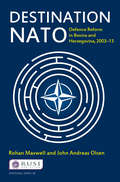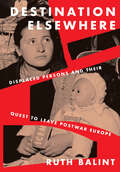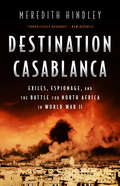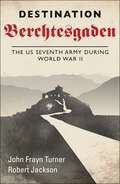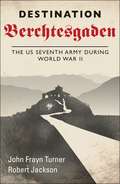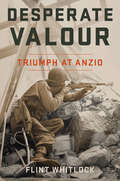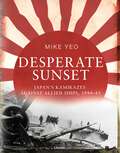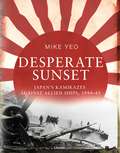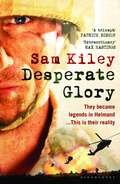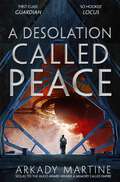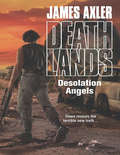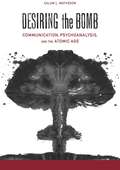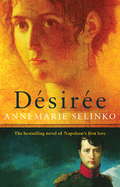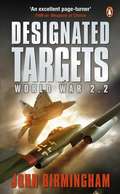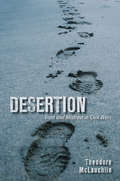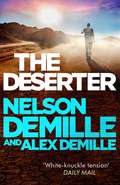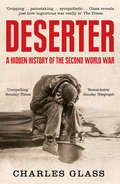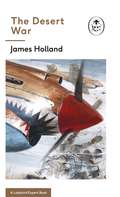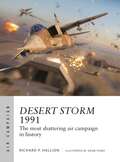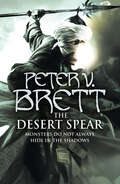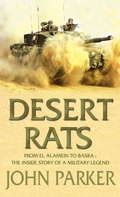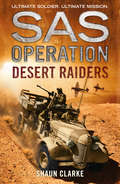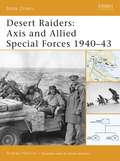- Table View
- List View
Destination NATO: Defence Reform in Bosnia and Herzegovina, 2003–13 (Whitehall Papers)
by Rohan Maxwell John Andreas OlsenDefence reform has been a major component of Bosnia’s stabilisation and nation-building. Though true for many cases of post-conflict transition, it is especially so for Bosnia, which arguably has the most complex state structure in Europe. Ten years on from the start of Bosnia’s defence-reform process, Destination NATO records and reviews the Bosnian experience of defence reform. The monograph offers policy-makers, practitioners and academics knowledge of the specific case of Bosnia and Herzegovina, and makes these insights relevant to defence-reform efforts in other contexts. The research is based on original sources and an extensive set of interviews and talks with key individuals including ambassadors, ministers and civil servants, and other senior national and international actors, in addition to discussions with several hundred politicians at local levels, students and NGO representatives. The authors also use their first-hand knowledge and insights to complement the documentation, interviews and discussions.
Destination Elsewhere: Displaced Persons and Their Quest to Leave Postwar Europe
by Ruth BalintIn this unique "history from below," Destination Elsewhere chronicles encounters between displaced persons in Europe and the Allied agencies who were tasked with caring for them after the Second World War. The struggle to define who was a displaced person and who was not was a subject of intense debate and deliberation among humanitarians, international law experts, immigration planners, and governments. What has not adequately been recognized is that displaced persons also actively participated in this emerging refugee conversation. Displaced persons endured war, displacement, and resettlement, but these experiences were not defined by passivity and speechlessness. Instead, they spoke back, creating a dialogue that in turn helped shape the modern idea of the refugee. As Ruth Balint shows, what made a good or convincing story at the time tells us much about the circulation of ideas about the war, the Holocaust, and the Jews. Those stories depict the emerging moral and legal distinction between economic migrants and political refugees. They tell us about the experiences of women and children in the face of new psychological and political interventions into the family. Stories from displaced persons also tell us something about the enduring myth of the new world for people who longed to leave the old. Balint focuses on those persons whose storytelling skills became a major strategy for survival and escape out of the displaced persons' camps and out of the Europe. Their stories are brought to life in Destination Elsewhere, alongside a new history of immigration, statelessness, and the institution of the postwar family.
Destination Casablanca: Exile, Espionage, and the Battle for North Africa in World War II
by Meredith HindleyThis rollicking and panoramic history of Casablanca during the Second World War sheds light on the city as a key hub for European and American powers, and a place where spies, soldiers, and political agents exchanged secrets and vied for control. In November 1942, as a part of Operation Torch, 33,000 American soldiers sailed undetected across the Atlantic and stormed the beaches of French Morocco. Seventy-four hours later, the Americans controlled the country and one of the most valuable wartime ports: Casablanca.In the years preceding, Casablanca had evolved from an exotic travel destination to a key military target after France's surrender to Germany. Jewish refugees from Europe poured in, hoping to obtain visas and passage to the United States and beyond. Nazi agents and collaborators infiltrated the city in search of power and loyalty. The resistance was not far behind, as shopkeepers, celebrities, former French Foreign Legionnaires, and disgruntled bureaucrats formed a network of Allied spies. But once in American hands, Casablanca became a crucial logistical hub in the fight against Germany--and the site of Roosevelt and Churchill's demand for "unconditional surrender."Rife with rogue soldiers, power grabs, and diplomatic intrigue, Destination Casablanca is the riveting and untold story of this glamorous city--memorialized in the classic film that was rush-released in 1942 to capitalize on the drama that was unfolding in North Africa at the heart of World War II.
Destination Casablanca: Exile, Espionage, and the Battle for North Africa in World War II
by Meredith HindleyThis rollicking and panoramic history of Casablanca during the Second World War sheds light on the city as a key hub for European and American powers, and a place where spies, soldiers, and political agents exchanged secrets and vied for control. In November 1942, as a part of Operation Torch, 33,000 American soldiers sailed undetected across the Atlantic and stormed the beaches of French Morocco. Seventy-four hours later, the Americans controlled the country and one of the most valuable wartime ports: Casablanca. In the years preceding, Casablanca had evolved from an exotic travel destination to a key military target after France's surrender to Germany. Jewish refugees from Europe poured in, hoping to obtain visas and passage to the United States and beyond. Nazi agents and collaborators infiltrated the city in search of power and loyalty. The resistance was not far behind, as shopkeepers, celebrities, former French Foreign Legionnaires, and disgruntled bureaucrats formed a network of Allied spies. But once in American hands, Casablanca became a crucial logistical hub in the fight against Germany -- and the site of Roosevelt and Churchill's demand for "unconditional surrender." Rife with rogue soldiers, power grabs, and diplomatic intrigue, Destination Casablanca is the riveting and untold story of this glamorous city--memorialized in the classic film that was rush-released in 1942 to capitalize on the drama that was unfolding in North Africa at the heart of World War II.
Destination Berchtesgaden: The US Seventh Army during World War II (Osprey Digital Generals Ser.)
by John Frayn Turner Robert JacksonOf the US Armies fighting in Europe at the end of World War II, General Patch's Seventh Army has received the least attention from historians. Although over-shadowed by the performance of General Patton and the actions of his US Third Army (breaking out of the Normandy bridgehead, liberating Paris and seizing Remagen bridge), the Seventh Army made a considerable contribution to the Allied victory, particularly their rapid advance through southern Germany and Austria. The Seventh Army landed in Sicily in 1943, and then took part in Operation Anvil in 1944 before advancing across the Rhine and reaching Berchtesgaden itself. Both the successes and setbacks of the Seventh Army are discussed in this volume, as well as discussing the tactical victories and defeats that contributed to the Allied campaign.
Destination Berchtesgaden: The US Seventh Army during World War II
by John Frayn Turner Robert JacksonOf the US Armies fighting in Europe at the end of World War II, General Patch's Seventh Army has received the least attention from historians. Although over-shadowed by the performance of General Patton and the actions of his US Third Army (breaking out of the Normandy bridgehead, liberating Paris and seizing Remagen bridge), the Seventh Army made a considerable contribution to the Allied victory, particularly their rapid advance through southern Germany and Austria. The Seventh Army landed in Sicily in 1943, and then took part in Operation Anvil in 1944 before advancing across the Rhine and reaching Berchtesgaden itself. Both the successes and setbacks of the Seventh Army are discussed in this volume, as well as discussing the tactical victories and defeats that contributed to the Allied campaign.
Desperate Valour: Triumph at Anzio
by Flint WhitlockA riveting and comprehensive account of the Battle of Anzio and the Alamo-like stand of American and British troops that turned certain defeat into victory The four-month-long 1944 battle on Italy's coast, south of Rome, was one of World War II's longest and bloodiest battles. Surrounded by Nazi Germany's most fanatical troops, American and British amphibious forces endured relentless mortar and artillery barrages, aerial bombardments, and human-wave attacks by infantry with panzers. Through it all, despite tremendous casualties, the Yanks and Tommies stood side by side, fighting with, as Winston Churchill said, "desperate valour." So intense and heroic was the fighting that British soldiers were awarded two Victoria Crosses, while American soldiers received twenty-six Medals of Honor--ten of them awarded posthumously. The unprecedented defensive stand ended with the Allies breaking out of their besieged beachhead and finally reaching their goal: Rome. They had truly snatched victory from the jaws of defeat. Award-winning author and military historian Flint Whitlock uses official records, memoirs, diaries, letters, and interviews with participants to capture the desperate nature of the fighting and create a comprehensive account of the unrelenting slugfest at Anzio.Desperate Valour is a stirring chronicle of courage beyond measure.
Desperate Sunset: Japan’s kamikazes against Allied ships, 1944–45
by Mike YeoBy the middle of 1944, Imperial Japan's armed forces were in an increasingly desperate situation. Its elite air corps had been wiped out over the Solomons in 1942–43, and its navy was a shadow of the force that had attacked Pearl Harbor in 1941. But the Japanese had one last, desperate, card to play. The Japanese High Command decided that the way to inflict maximum damage on the superior enemy forces was to get the poorly trained Japanese pilots to crash their explosive-laden aircraft onto their target, essentially turning themselves into a guided missile. The kamikazes announced themselves in the immediate aftermath of the Leyte Gulf naval battles, sinking the USS St. Lo and damaging several other ships. The zenith of the kamikaze came in the battle of Okinawa, which included ten kikusui (Floating Chrysanthemum) operations which involved up to several hundred aircraft attacking the US fleet.Fully illustrated throughout, Desperate Sunset examines the development and evolution of the kamikaze using first-hand accounts, combat reports and archived histories.
Desperate Sunset: Japan’s kamikazes against Allied ships, 1944–45
by Mike YeoBy the middle of 1944, Imperial Japan's armed forces were in an increasingly desperate situation. Its elite air corps had been wiped out over the Solomons in 1942–43, and its navy was a shadow of the force that had attacked Pearl Harbor in 1941. But the Japanese had one last, desperate, card to play. The Japanese High Command decided that the way to inflict maximum damage on the superior enemy forces was to get the poorly trained Japanese pilots to crash their explosive-laden aircraft onto their target, essentially turning themselves into a guided missile. The kamikazes announced themselves in the immediate aftermath of the Leyte Gulf naval battles, sinking the USS St. Lo and damaging several other ships. The zenith of the kamikaze came in the battle of Okinawa, which included ten kikusui (Floating Chrysanthemum) operations which involved up to several hundred aircraft attacking the US fleet.Fully illustrated throughout, Desperate Sunset examines the development and evolution of the kamikaze using first-hand accounts, combat reports and archived histories.
Desperate Glory: 'taste The Bullets And The Fear - Kiley Takes The Reader Into The Heart Of The Afghan Nightmare'
by Sam KileyIn the dust and blazing heat of Helmand, the young men of 16 Air Assault Brigade find themselves in the most relentless battles faced by British troops in recent history. As the only writer to have obtained unprecedented, unrestricted access to the front line, Sam Kiley is with them to bear witness to the most intense challenges of their lives. Desperate Glory is an unflinching portrait of the reality of war - the bombs, the shooting and the daily struggles that push them to the very limit of human endurance.
A Desolation Called Peace (Teixcalaan #2)
by Arkady MartineA Desolation Called Peace is the spectacular space opera sequel to A Memory Called Empire by Arkady Martine, winner of the 2020 Hugo Award for Best Novel. An alien terror could spell our end.An alien threat lurks on the edges of Teixcalaanli space. No one can communicate with it, no one can destroy it, and Fleet Captain Nine Hibiscus is supposed to win a war against it.In a desperate attempt to find a diplomatic solution, the fleet captain has sent for an envoy to contact the mysterious invaders. Now Mahit Dzmare and Three Seagrass – both still reeling from the recent upheaval in the Empire – face an impossible task: they must attempt to negotiate with a hostile entity, without inadvertently triggering the destruction of themselves and the Empire.Whether they succeed or fail could change the face of Teixcalaan forever.‘All-round brilliant space opera, I absolutely loved it’ Ann Leckie on A Memory Called Empire‘A cutting, beautiful, human adventure . . . The best SF novel I’ve read in the last five years’ Yoon Ha Lee on A Memory Called Empire
Desolation Angels
by James AxlerA hundred years after the nukecaust, the tortured landscape of post apocalyptic America offers a brutal fight for survival. Yet tech secrets lie hidden, useful to those brave and strong enough to believe that hope can carry them toward ever-elusive peace.
Desiring The Bomb: Communication, Psychoanalysis, and the Atomic Age (PDF) (Albma Rhetoric Cult And Soc Crit Ser.)
by Calum Lister MathesonA timely interdisciplinary study that applies psychoanalysis and the rhetorical tradition of the sublime to examine the cultural aftermath of the Atomic Age. Every culture throughout history has obsessed over various "end of the world" scenarios. The dawn of the Atomic Age marked a new twist in this tale. For the first time, our species became aware of its capacity to deliberately destroy itself. Since that time the Bomb has served as an organizing metaphor, a symbol of human annihilation, a stand-in for the unspeakable void of extinction, and a discursive construct that challenges the limits of communication itself. The parallel fascination with and abhorrence of nuclear weapons has metastasized into a host of other end-of-the-world scenarios, from global pandemics and climate change to zombie uprisings and asteroid collisions. Desiring the Bomb: Communication, Psychoanalysis, and the Atomic Age explores these world-ending fantasies through the lens of psychoanalysis to reveal their implications for both contemporary apocalyptic culture and the operations of language itself. What accounts for the enduring power of the Bomb as a symbol? What does the prospect of annihilation suggest about language and its limits? Thoroughly researched and accessibly written, this study expands on the theories of Kenneth Burke, Jacques Lacan, Sigmund Freud, and many others from a variety of disciplines to arrive at some answers to these questions. Calum L. Matheson undertakes a series of case studies-including the Trinity test site, nuclear war games, urban shelter schemes, and contemporary survivalism-and argues that contending with the anxieties (individual, social, cultural, and political) born of the Atomic Age depends on rhetorical conceptions of the "real," an order of experience that cannot be easily negotiated in language. Using aspects of media studies, rhetorical theory, and psychoanalysis, the author deftly engages the topics of Atomic Age survival, extinction, religion, and fantasy, along with their enduring cultural legacies, to develop an account of the Bomb as a signifier and to explore why some Americans have become fascinated with fantasies of nuclear warfare and narratives of postapocalyptic rebirth.
Desiree: The most popular historical romance since GONE WITH THE WIND (Novela Historica Ser.)
by Annemarie SelinkoThe bestselling novel about Napoleon's first loveOne of the most successful historical romances since GONE WITH THE WINDOver 20 million copies sold worldwideTo be young, in France, and in love: fourteen year old Desiree can't believe her good fortune. Her fiance, a dashing and ambitious Napoleon Bonaparte, is poised for battlefield success, and no longer will she be just a French merchant's daughter. She could not have known the twisting path her role in history would take, nearly breaking her vibrant heart but sweeping her to a life rich in passion and desire.A love story, but so much more, Désirée explores the landscape of a young heart torn in two, giving readers a compelling true story of an ordinary girl whose unlikely brush with history leads to a throne no one would have expected.An epic bestseller that has earned both critical acclaim and mass adoration, Désirée is at once a novel of the rise and fall of empires, the blush and fade of love, and the heart and soul of a woman.
Designated Targets: World War 2.2 (Axis Of Time Ser. #2)
by John BirminghamThe Second World War was turned on its head at the moment Admiral Kolhammer’s ultra-modern stealth warships were hurled back through time from 2021. But no one could have predicted just how much of a nightmare would ensue . . . Only months after the Transition, the great powers scramble to develop the weapons of tomorrow. The year 1942 is now a world of crude jet fighters, monstrous attack helicopters, and unholy dirty bombs — a mongrel technology, born decades prematurely. Then, in a radical rewriting of history, Japanese forces sweep into Australia, foreign agents begin a campaign of terror in the USA, and Germany prepares for an all-out attack on Britain. The twenty-first-century forces must resort to the most extreme measures yet and face a future rife with possibilities — all of them apocalyptic . . . Picking up from where he left off with Weapons of Choice, John Birmingham shocks and awes us with this gripping second instalment in the Axis of Time trilogy.
Design and Technology Foundations: KS3 (PDF)
by Julie Boyd Debbie Eason Geraldine George Peter Anderson'Design and Technology Foundations' student books are matched to the KS3 assessment criteria and programme of study, with engaging content and activities to help develop the design skills and knowledge required at Key Stage 3 and beyond.
Desertion: Trust and Mistrust in Civil Wars
by Theodore McLauchlinTheodore McLauchlin's Desertion examines the personal and political factors behind soldiers' choices to stay in their unit or abandon their cause. He explores what might spur widespread desertion in a given group, how some armed groups manage to keep their soldiers fighting over long periods, and how committed soldiers are to their causes and their comrades.To answer these questions, McLauchlin focuses on combatants in military units during the Spanish Civil War. He pushes against the preconception that individual soldiers' motivations are either personal or political, either selfish or ideological. Instead, he draws together the personal and the political, showing how soldiers come to trust each other—or not. Desertion demonstrates how the armed groups that hold together and survive are those that foster interpersonal connections, allowing soldiers the opportunity to prove their commitment to the fight.McLauchlin argues that trust keeps soldiers in the fray, mistrust pushes them to leave, and political beliefs and military practices shape both. Desertion brings the reader into the world of soldiers and rigorously tests the factors underlying desertion. It asks, honestly and without judgment, what would you do in an army in a civil war? Would you stand and fight? Would you try to run away? And what if you found yourself fighting for a cause you no longer believe in or never did in the first place?
The Deserter: A Novel (Scott Brodie Ser.)
by Nelson DeMille Alex DeMilleMilitary cop Scott Brodie is the guy you send in when the other guys can't solve a case. Now he's on the hunt for a dangerous ex-Delta Force deserter named Kyle Mercer, and may have met his match.***The brand new novel from America's Greatest Living Thriller Writer.***When Delta Force Captain Kyle Mercer disappeared from his post in Afghanistan, a video released by his Taliban captors made international headlines. But circumstances were murky: Did Mercer desert before he was captured? Then a second video sent to Mercer's Army commanders leaves no doubt: the trained assassin and keeper of classified Army intelligence has willfully disappeared.When Mercer is spotted a year later in Caracas, Venezuela, top military brass task Scott Brodie and Maggie Taylor of the Criminal Investigation Division to fly to Venezuela and bring Mercer back to America-dead or alive. Brodie knows this is a difficult mission, made more difficult by his new partner's inexperience and by his suspicion that Maggie Taylor is reporting to the CIA.Tense, exotic and inspired by a real-life story, the new thriller from number one New York Times bestseller Nelson DeMille and his son, screenwriter Alex DeMille is an absolute must read.
Deserter: The Last Untold Story Of The Second World War
by Charles GlassThe extraordinary story of the deserters of the Second World War. Who were they? What made them run? And what happened once they made the decision to flee?
The Desert War: Book 4 of the Ladybird Expert History of the Second World War (The Ladybird Expert Series)
by James Holland Keith BurnsPart of the ALL-NEW LADYBIRD EXPERT SERIES.____________Why was North Africa such a key component in Britain's success over Mussolini and his Italian Army?How did they blunt Italy's actions?What challenges did they face?And what new technologies were brought to bear?When fascist dictator Mussolini declared war against Britain he was taking a huge risk . . . Italy lacked natural resources, and Britain and France's wealth.He hoped to create a new Roman Empire across the Mediterranean and into Africa. And with Hitler and the Nazi's by his side he had a great chance of doing so - but what was it that stopped him?Discover the answers and more inside James Holland's The Desert War, the thrilling and accessible account that explains what happened, who the key figures were and the tactics, triumphs and failures on both sides . . .
Desert Storm 1991: The most shattering air campaign in history (Air Campaign)
by Richard P. HallionAn expertly written, illustrated new analysis of the Desert Storm air campaign fought against Saddam Hussein's Iraq, which shattered the world's fourth-largest army and sixth-largest air force in just 39 days, and revolutionized the world's ideas about modern air power.Operation Desert Storm took just over six weeks to destroy Saddam Hussein's war machine: a 39-day air campaign followed by a four-day ground assault. It shattered what had been the world's fourth-largest army and sixth-largest air force, and overturned conventional military assumptions about the effectiveness and value of air power.In this book, Richard P. Hallion, one of the world's foremost experts on air warfare, explains why Desert Storm was a revolutionary victory, a war won with no single climatic battle. Instead, victory came thanks largely to a rigorously planned air campaign. It began with an opening night that smashed Iraq's advanced air defense system, and allowed systematic follow-on strikes to savage its military infrastructure and field capabilities. When the Coalition tanks finally rolled into Iraq, it was less an assault than an occupation.The rapid victory in Desert Storm, which surprised many observers, led to widespread military reform as the world saw the new capabilities of precision air power, and it ushered in today's era of high-tech air warfare.
The Desert Spear: The Painted Man, The Desert Spear (The Demon Cycle #2)
by Peter V. BrettContinuing the impressive debut fantasy series from author Peter V. Brett, The Desert Spear is book two of the Demon Cycle, pulling the reader into a world of demons, darkness and heroes.
Desert Rats: From El Alamein To Basra - The Inside Story Of A Military Legend
by John ParkerIn the recent war in Iraq, the 7th Armoured Brigade, bearers of the Desert Rats insignia, was immediately engaged in some of the fiercest early fighting, ultimately taking Basra for the Allies. The war in Iraq revived public focus on the Desert Rats whose famous battles of World War II helped turn the tide of German dominance. After World War II the Desert Rats re-emerged as part of the NATO forces during the Cold War years, and in other major deployments in the 1991 Gulf War, Bosnia and Kosovo. In this latest of his military histories, John Parker once again draws heavily on the drama of first-hand accounts for a story that is a seminal part of modern military history.
Desert Raiders (SAS Operation)
by Shaun ClarkeUltimate soldier. Ultimate mission. But can the SAS face the might of Rommel’s army and win?
Desert Raiders: Axis and Allied Special Forces 1940–43 (Battle Orders)
by Andrea MolinariAlthough harsh and inhospitable, the North African theatre of World War II proved to be a perfect environment for irregular warfare and the deployment of Special Forces. Following Italy's entry into the war in June 1940, the Western Desert became the background for a long conflict dominated by motorized units. The major combatants Great Britain, Free France, Italy and Germany all developed irregular units to exploit the unique conditions of the region with varying degrees of success. This book details the genesis, organization and tactics of these forces, including such famous units as the Long Range Desert Group and the Special Air Service.
